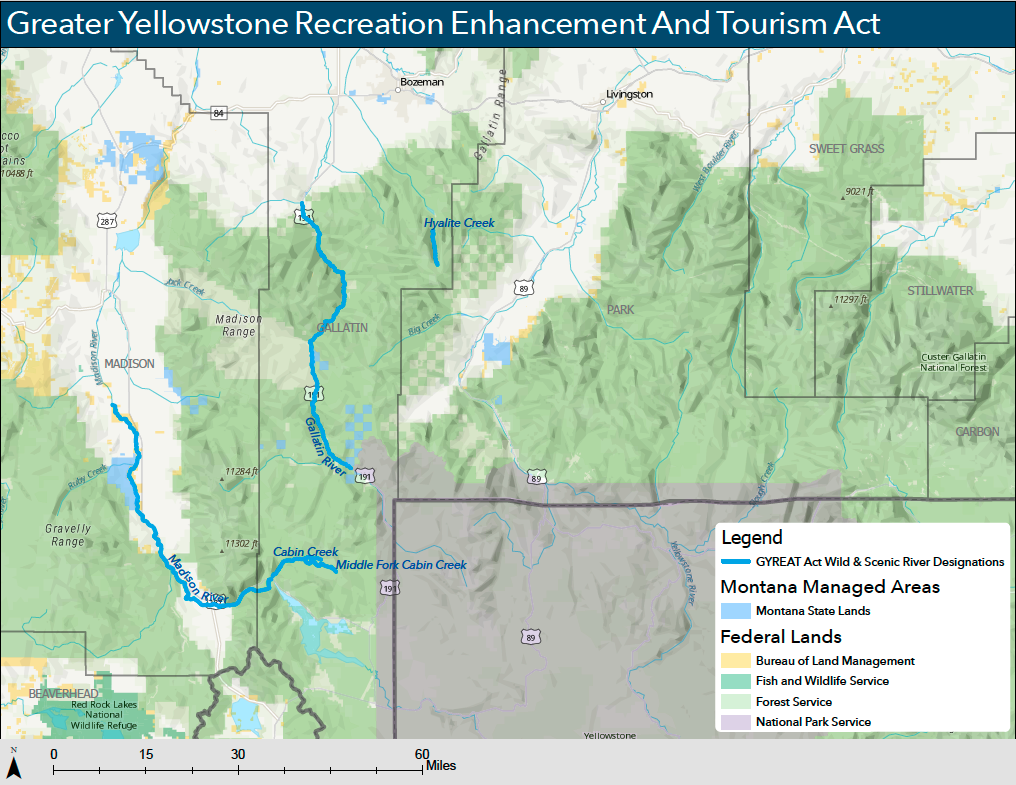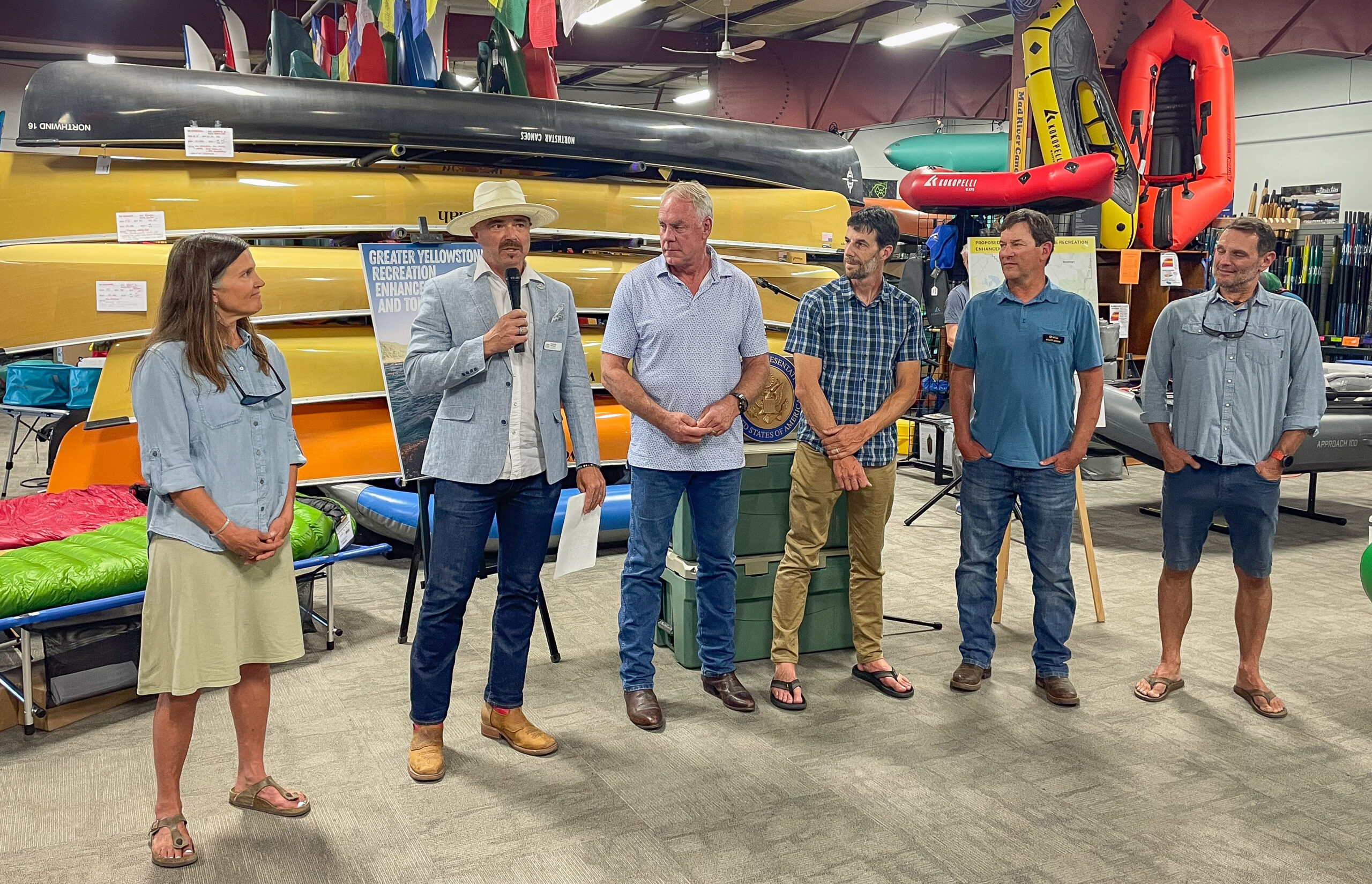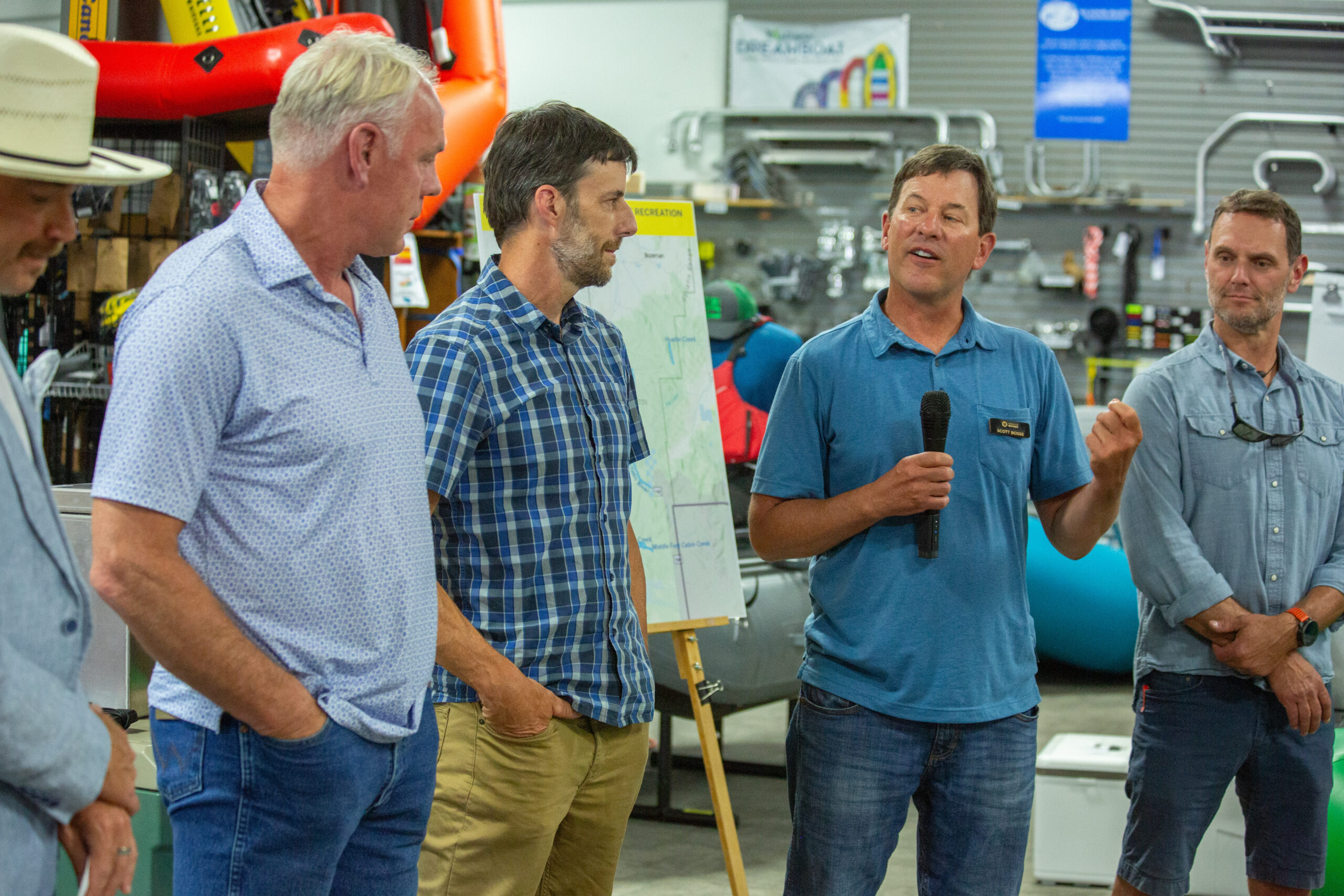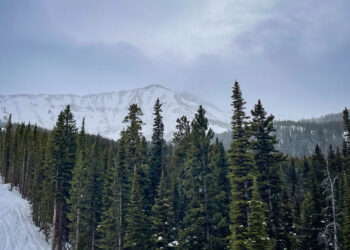Act emphasizes economic impact generated by ‘outstandingly remarkable’ streams
By Jack Reaney SENIOR EDITOR
On Tuesday afternoon, July 29, Rep. Ryan Zinke held a press conference in Bozeman to announce his new river protection bill, the Greater Yellowstone Recreation Enhancement and Tourism Act.
Leaders from conservation groups Greater Yellowstone Coalition, American Whitewater, Gallatin River Task Force and American Rivers attended and spoke in support of the bill.
“I think this is an example of bipartisanship, certainly our public lands,” Zinke said, standing at a raft-cooler-podium in front of stacked canoes at Bozeman outdoor gear shop Northern Lights Rivers, Lakes and Oceans. “… We also want to make sure we preserve and protect the systems and the health of the systems and the rivers and that legacy that’s part of it.”
Zinke’s GYREAT Act proposes to amend the National Wild and Scenic Rivers System to include the following segments: roughly 39.5 miles of the Gallatin River from the Yellowstone National Park boundary downstream to the Spanish Creek confluence; roughly 42 miles of the Madison River from the Cabin Creek confluence downstream to approximately one mile north of Cherry Creek; 7.3 miles of Cabin Creek (Madison River) from its source to the fish barrier; and 5.1 miles of the Middle Fork of Cabin Creek from its source to the Cabin Creek confluence; and 4.6 miles of Hyalite Creek from its source to the Grotto Falls trailhead.

The bill protects existing water rights and commercial dam operations, including licensing and operations of the Hebgen Dam.
“Striking the right balance between conservation and multiple use of our resources is the Montana way. These rivers support everything from family farms to fly shops, ranchers to rafters, and literally power our community,” Rep. Zinke stated in a July 29 press release. “Madison and Gallatin Counties both rely on these waters for irrigation and energy, but also for the outdoor recreation economy that fuels small businesses and draws visitors from around the world. This bill strikes the right balance between preserving what we treasure, maintaining access for recreation, and ensuring continued operation of the existing dams on the river.”
The bill is written to explicitly maintain public access, allowing for emergency response and ensuring no land will be acquired without the owner’s consent.

The GYREAT Act garnered letters of support from the elected commissioners of Gallatin and Madison counties.
Gallatin County Commissioners Jennifer Boyer, Zach Brown and Scott MacFarlane wrote that healthy rivers are the lifeblood of the county, sustaining drinking water resources, irrigation, industry, world-class outdoor recreation, fish and wildlife, and “key sectors” of the region’s economy.
“This effort enjoys broad, bipartisan support across Montana—from farmers and ranchers to business owners, conservationists, sportsmen and local governments—reflecting a shared understanding that safeguarding our rivers is not a partisan issue, but a Montana value,” the Gallatin County commissioners wrote.
Madison County Commissioners Duke Gilman, Ron Nye and Bill Todd echoed their counterparts’ rationale, adding that these rivers attract people from across the country who value the region’s quality of life.
“On behalf of Madison County Commission, we are writing to strongly support federal legislation to designate sections of the Gallatin, Madison, and Yellowstone Rivers as part of the National Wild and Scenic Rivers System. These rivers support more than just the landscapes they flow through,” the Madison County commissioners wrote.
‘A huge win,’ conservationists say
The new bill follows multiple failed efforts by former Sen. Jon Tester to pass the Montana Headwaters Legacy Act, which proposed to designate 384 Montana river miles as Wild and Scenic including the 100 featured in Zinke’s bill. Notable exclusions between the failed MHLA and Zinke’s new GYREAT Act include 24 miles of the Smith River, 33 miles of the Boulder River, 19 miles of the Yellowstone River, and numerous lengthy tributaries of those rivers.
Kristin Gardner, chief executive and science officer for the Gallatin River Task Force, worked hard for years to promote the Montana Headwaters Legacy Act. She told EBS that although this bill is smaller in scope, it’s still “a huge win” to see the Madison and Gallatin protected.
“Hopefully in the future we can see more rivers brought into the Wild and Scenic Rivers System, but for now, we’ll take what we can get,” she told EBS. “This is a huge deal, this is so awesome… And I really feel more optimistic about it moving forward and getting signed [into law] this year than in the past, so really appreciative of Congressman Zinke’s leadership on this.”
Another conservationist who supported the MHLA and spoke at Zinke’s event was Scott Bosse, Northern Rockies regional director for American Rivers. He, too, emphasized that 100 miles is nothing to sneeze at.

“We gotta protect as much as we can… There’s still an opportunity to protect [other rivers] in the future, and we’ll do it,” Bosse told EBS. “We’ll work our hardest to get rivers like the Yellowstone, the Boulder and the West Boulder and Stillwater protected. But yeah, it’s definitely a big win.
“Especially in this political environment, if you can get a bipartisan Wild and Scenic River bill passed to protect 100 river miles, it could be the biggest river bill to pass in this session of congress. So I’d be super proud if we get it done. I think we will.”
In the bill’s description of purpose, it notes that the listed rivers are “cherished by the people of the State of Montana and visitors from across the United States and around the world for their clean water, abundant fish and wildlife, spectacular natural settings, and outstanding recreational opportunities” including fishing, hunting, camping, paddling, hiking, swimming, rock climbing, horseback riding, and wildlife watching. Those activities and surrounding land “generate billions of dollars annually for the economy of the State of Montana,” including the state’s multi-billion-dollar agricultural industry, the bill states.
The bill also notes that native peoples have used the streams “since time immemorial,” and adds that its purpose is to “to preserve and protect for present and future generations the outstandingly remarkable values of each stream and tributary.”
Eric Ladd, founder and CEO of Outlaw Partners—publisher of Explore Big Sky—introduced Rep. Zinke at Tuesday’s event, offering his gratitude for the congressman’s leadership.

“I am really grateful that one of the people who are serving our country took a moment to listen,” Ladd said. “… It means a lot to not only Montana, but it means a lot to our country to see a leader that is willing to work with parties that sometimes don’t work together, but work in a very collaborative way.”
Zinke, a Bozeman native, noted that in his lifetime public access in the region has been stifled by fences and high traffic, further justifying protections such as the GYREAT Act.
“Why are we here,” Zinke asked. “We’re here because we love the rivers, and we love the outdoor experience.”














